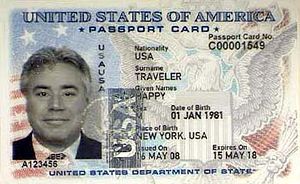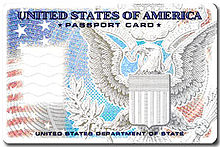- Passport card
-
The passport card (previously known as the People Access Security Service Card, or PASS Card) is an alternative to a passport produced in the United States to meet the documentary requirements of the Western Hemisphere Travel Initiative. The U.S. Passport Card is a wallet-size travel document, issued to U.S. citizens only, that can be used to enter the United States from Canada, Mexico, the Caribbean, and Bermuda at land border crossings or sea ports-of-entry and is more convenient and less expensive than a passport book. The passport card cannot be used for international air travel.
Applications have been accepted since February 1, 2008; the cards were made available to the public beginning in July 2008.[1] As of March 2010, more than 2,700,000 Passport Cards had been issued to U.S. citizens.[2]. The card is manufactured by L-1 Identity Solutions [3]. Identity cards with the same objectives are common inside the European Union for both national and international use.
Contents
Rationale
The passport card is an alternative to an ordinary U.S. passport booklet for land and sea travel within North America (Canada, Mexico, the Caribbean, and Bermuda). Like the passport book, the passport card is issued only to U.S. citizens and nationals. However, the passport card cannot currently be used for international air travel. The Department of State indicates that this is because "designing a card format passport for wide use, including by air travelers, would inadvertently undercut the broad based international effort to strengthen civil aviation security and travel document specifications to address the post 9/11 threat environment."[4]
The passport card is being issued by the United States Department of State in response to border community residents' needs for a less expensive and more portable alternative to the conventional booklet since the Western Hemisphere Travel Initiative's requirements for travelers to carry a single document verifying both identification and citizenship have come into effect. In an effort to improve efficiency at land crossings, the passport card also includes a vicinity-read radio frequency identification chip with a unique identifying number tied to government databases; unlike the passport book, the RFID chip in the passport card is designed to be readable at a greater distance and will not contain any information from the MRZ of the passport card beyond the identifying number. To prevent the RFID chip from being read when the card is not being used, the passport card comes with a sleeve designed to block RFID while inside.[5]
Under the REAL ID Act, the passport card will also be accepted for federal purposes (such as domestic air travel or entering federal buildings), which may make it an attractive option for people living in states whose driver's licenses and ID cards are not REAL ID-compliant when those requirements go into effect. TSA regulations list the passport card as an acceptable identity document at airport security checkpoints.[6]
U.S. Citizenship and Immigration Services has indicated that the U.S. Passport Card may be used in the Employment Eligibility Verification Form I-9 process[7]. The passport card is considered a “List A” document that may be presented by newly hired employees during the employment eligibility verification process to show work authorized status. “List A” documents are those used by employees to prove both identity and work authorization when completing the Form I-9.
According to the US consulate in Germany, the passport card can be used as a valid proof of citizenship and proof of identity both inside and outside the United States[8]. However, the acceptance of the passport card as the identity document by private and governmental entities within the USA varies greatly.
Validity and fees
The passport card will share the same validity period as the passport book: 10 years for persons 16 and over, 5 years for children under 16. As of July 13, 2010, the passport card renewal fee for eligible applicants (adults only, by mail) is $30; first-time applicants and those applying in person must also pay a $25 processing fee, for a total fee of $55. Passport cards for children must be applied for in person; the total fee is $40, including the $25 processing fee.
Adults who already have a fully valid passport book may pay a fee of $30 to apply for the card as a passport renewal.
A citizen or national is allowed to hold both a card passport and a booklet passport. A passport in either form entitles its holder to apply for the other form (or both forms) as a "renewal" by mail at the end of its validity period.
Card layout
The passport card is formatted according to specifications for credit-card (ID-1) sized travel documents, as described in ICAO Document 9303, Part 3, Volume 1. The card contains both human-readable and machine-readable information; the latter is printed in the machine-readable zone on the rear of the card as OCR-readable text in a similar format as on the identity page of the passport book. The zone starts with the letters IP (designated by ICAO for passport card[9]), followed by the issuing country code USA and the holder's name: IPUSA. The general layout of the Passport Card is virtually identical to the layout of the Border Crossing Card issued to Mexican citizens with primarily the background imagery and entitlements varying between the two cards.
Anti-counterfeiting features
In addition to the embedded RFID chip, the front of the card features a complex multi-layer hologram consisting of an American bald eagle surrounded by the words "United States of America Department of State" in a small clearly readable font, further surrounded by the same words repeatedly in microprint. The card's background consists of interweaving smooth curves rich in variable color and microprint. Most of the information on the card is printed as intaglio (raised) print, with the date of birth, vertical letters "USA", and an alphanumeric sequence underneath the laser etched main photograph being particularly prominent. A second, smaller "photograph" is included on the right side of the card; when closely inspected this "photo" is actually an approximation of the shading in the original photo composed of various letters from the card holders name. There is also an embossed seal in the upper left hand corner of the card (partially overlapping the photograph) reminiscent of the eagle grasping 13 arrows and an olive branch that appears on the back of a US one dollar bill. On the rear of the card, the "PASSsystem" mark appears in color-shifting ink.
Countries
Passport cards can be used in the following countries (when travelling via land border or boat)[10]:
 Anguilla
Anguilla
 Antigua and Barbuda
Antigua and Barbuda
 Aruba
Aruba
 Caribbean Netherlands
Caribbean Netherlands
 Bahamas
Bahamas
 Bermuda
Bermuda
 British Virgin Islands
British Virgin Islands
 Canada
Canada
 Cayman Islands
Cayman Islands
 Dominica
Dominica
 Dominican Republic
Dominican Republic
 Grenada
Grenada
 Jamaica
Jamaica
 Mexico
Mexico
 Montserrat
Montserrat
 Saint Kitts and Nevis
Saint Kitts and Nevis
 Saint Lucia
Saint Lucia
 Saint Vincent and the Grenadines
Saint Vincent and the Grenadines
 Turks and Caicos Islands
Turks and Caicos IslandsSee also
- United States passport
- NEXUS, a similar, Western Hemisphere Travel Initiative approved, document for crossing the United States/Canada border.
- Proximity card
References
- ^ U.S. PASSPORT CARD. Retrieved 17 April 2008.
- ^ U.S. Passport Card FAQ
- ^ Passport Card & Border Crossing Card Solutions. Retrieved 24 May 2011
- ^ Federal Register, Volume 71 Issue 200 US Government Printing Office October 17, 2006 (Accessed Aug 4, 2010).
- ^ U.S. Passport Card. Retrieved February 5, 2009.
- ^ Driver's License or Passports Preferred ID at Checkpoints, retrieved May 30, 2008.
- ^ USCIS - USCIS Informs The Public That New Passport Card Is Acceptable For Employment Eligibility Verification
- ^ Passport Card
- ^ see page V-11 of ICAO9303 part 3
- ^ http://www.travel.state.gov/travel/cis_pa_tw/cis_pa_tw_3256.html
External links
- Fact Sheet: Western Hemisphere Travel Initiative (WHTI) Passport Card Technology Choice: Vicinity RFID Release Date: October 17, 2006
- Fact Sheet: US Passport Card Release Date: January 8, 2008
Categories:- Expedited border crossing schemes
- International travel documents
- Passports
- Canada–United States relations
- United States–Caribbean relations
- Radio-frequency identification
Wikimedia Foundation. 2010.



